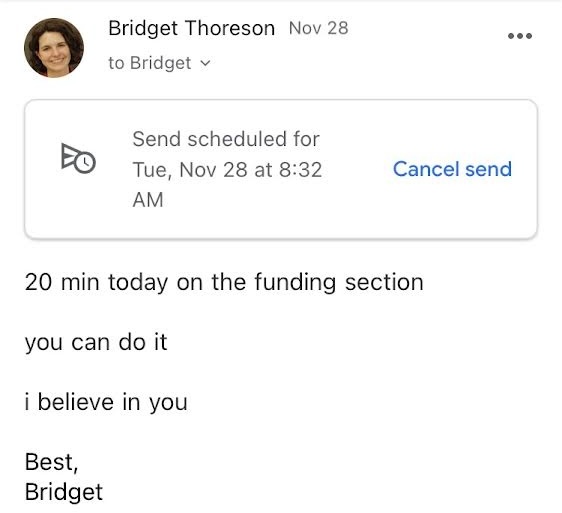Getting unstuck: Timing
🎉 We just passed a subscriber milestone! Explore Your Career River now has hundreds of regular readers. Thank you all for signing up and spreading the word! Next up: cracking the 1,000 mark.
We call it the 10-minute trick.
When there’s a chore we really don’t want to do (usually dishes), I tell my kids to set a timer and we only have to tackle the task for 10 minutes. By the end of the time, we’ve usually gotten most of it done. Sometimes we even find the determination to keep going and finish the job. And sometimes we just walk away, leaving the sink much clearer.
Getting started is often the hardest part, and the 10-minute trick gives us permission to progress without being perfect.
If only we could tackle career changes with the same ease. Instead, we search for the best possible role and stress about the gap between what’s on our resume and what we actually want to do.
There are two powerful forces at work here: our tendency to prioritize the needs of right now over long-term possibilities, and fear of failure. The river approach helps address both. Today we’ll tackle how we think about time, and what long-term thinking can do for you.
Minutes, months and years
Suzy Welch recognized the power of shifting your timeframe to help make decisions in her book 10-10-10: A Life-Transforming Idea. As she describes in this article, considering the consequences of your decision over the next 10 minutes, 10 months and 10 years can help you get unstuck even when you’re caught in a tough spot.
In one instance, she’d been asked to run an important meeting on a weekend, the same day her son would be recognized for years of hard work in karate. Over the coming minutes and months, both options had drawbacks, though Welch figured she could make it up to her son or boss in the short term to mitigate the damage.
“But 10 years...there was the problem. My kids would be gone and my career at full-throttle, whether I had gotten one promotion or not. But on some visceral level, my son would still know that I had chosen to miss one of the seminal events of his life for my own advancement.
“That was damage I could never undo.
“So I skipped the off-site. And late that Saturday afternoon, I cheered as my son received his black belt, his face pink as he tried to hold back tears.”
If we apply the same thinking to our career choices, today’s short-term choices start to look different. Instead, we should be asking ourselves what we can do now that will reflect our values and interests much farther along our career journey.
Looking out for Future You

I admit I also use the 10-minute trick (or 20, as the case may be) at work, either when I’m not sure where to start or when there never seems to be enough time to tackle a complex task.
I think of it as being kind to my future self — if I can make some progress now, that means I’ll be in a better position later.
Turns out I’m in good company. In Procrastination: A Scientific Guide on How to Stop Procrastinating, James Clear, the author of Atomic Habits, offers a 2-minute rule for starting new habits.
The 2–Minute Rule overcomes procrastination and laziness by making it so easy to start taking action that you can’t say no.
Another great way to make tasks more achievable is to break them down. For example, consider the remarkable productivity of the famous writer Anthony Trollope. He published 47 novels, 18 works of non-fiction, 12 short stories, 2 plays, and an assortment of articles and letters. How did he do it? Instead of measuring his progress based on the completion of chapters or books, Trollope measured his progress in 15-minute increments. He set a goal of 250 words every 15 minutes and he continued this pattern for three hours each day. This approach allowed him to enjoy feelings of satisfaction and accomplishment every 15 minutes while continuing to work on the large task of writing a book.
I’ve seen the difference this little bit at a time approach makes in my freelance gig writing book reviews. I review about 25 books a year, and read more for fun. I don’t always have my nose stuck in a book, but reading a little most days at breakfast and at night really adds up!
We can break down our career choices into manageable chunks, as when you test the waters of a new type of work before committing to a full-time job. These little investments of time can build something much bigger, if you give it long enough.
Ten minutes can inform your thinking (remember how we charted the skills threading through different roles in this 10-minute career river mapping exercise?). It can clear your sink of dishes or help you start a new habit. Give yourself permission to get unstuck, a little bit at a time.
Happy navigating,
Bridget
💡 Feeling Stuck? Here Are 5 Ways to Jumpstart Your Life. (New York Times)
Member discussion